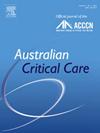儿科败血症后护理方案的新要素:范围审查
IF 2.7
3区 医学
Q2 CRITICAL CARE MEDICINE
引用次数: 0
摘要
败血症是澳大利亚儿童死亡的一个重要原因,尤其影响幼儿、已有健康问题的儿童以及土著和托雷斯海峡岛民。从医院到家庭的过渡对幸存者来说可能是具有挑战性的,往往留下无法解决的长期影响。本研究的目的是确定和描述现有的败血症后护理干预措施和儿科幸存者护理模式,目的是为败血症后护理途径的发展提供信息。方法JBI范围评估框架指导相关文献的识别和选择,系统评价的首选报告项目和元分析指南确保报告的透明度,模式推进差距证据用于实践和研究和建议框架支持分析和综合。同行评议的文献来源于数据库、Cochrane协作、参考书目和专家咨询。灰色文献是通过医疗保健和儿科组织网站的目标搜索确定的。结果在筛选的1843篇文献中,有8篇符合纳入标准:2篇同行评议文章和6篇灰色文献资源。描述了两种新兴的护理模式:费城儿童医院儿童败血症幸存者计划和昆士兰儿科败血症计划。费城儿童医院引入了护士协调员的角色进行出院教育,并在3个月后使用幸存者需求问卷进行随访。昆士兰儿科败血症项目开发了一个网页、视频、家庭登记处和一个与家庭共同设计的同伴导师项目。两者都强调社会心理支持和护理协调,尽管两者都没有正式的评估或可衡量的结果。灰色文献描述了没有明确干预措施的一般服务方法。结论儿童败血症后的结构化、可评估性护理存在证据缺口。仅确定了两种新兴的护理模式,均未进行正式评估。研究结果支持需要一个全面的、文化敏感的、以家庭为中心的护理模式,并为败血症后护理途径的试点发展提供了信息。本文章由计算机程序翻译,如有差异,请以英文原文为准。
Emerging elements of paediatric post-sepsis care programs: A scoping review
Background
Sepsis is a significant cause of mortality for children in Australia, particularly affecting young children, those with pre-existing health conditions and Aboriginal and Torres Strait Islander populations. The transition from hospital to home can be challenging for survivors, often leaving long-term impacts unaddressed.
Objectives
The objective of this study was to identify and describe existing post-sepsis care interventions and models of care for paediatric survivors, with the aim of informing the development of a post-sepsis care pathway.
Methods
The JBI Scoping Review Framework guided the identification and selection of relevant literature, Preferred Reporting Items for Systematic reviews and Meta-Analyses guidelines ensured transparent reporting, and the Patterns Advances Gaps Evidence for practice and Research and recommendations framework supported analysis and synthesis. Peer-reviewed literature was sourced from databases, the Cochrane Collaboration, reference lists, and expert consultations. Grey literature was identified through targeted searches of healthcare and paediatric organisation websites.
Results
Of 1843 records screened, eight met inclusion criteria: two peer-reviewed articles and six grey literature resources. Two emerging models of care were described: the Children's Hospital of Philadelphia Pediatric Sepsis Survivorship Program and the Queensland Paediatric Sepsis Program. The Children's Hospital of Philadelphia introduced a nurse coordinator role for discharge education and follow-up at 3 months utilising a survivor-needs questionnaire. The Queensland Paediatric Sepsis Program developed a webpage, videos, a family registry, and a peer mentor program codesigned with families. Both emphasised psychosocial support and care coordination, though neither had formal evaluations or measurable outcomes. Grey literature described general service approaches without defined interventions.
Conclusion
There is an evidence gap in structured, evaluated post-sepsis care for children. Only two emerging models of care were identified, neither formally assessed. Findings support the need for a comprehensive, culturally sensitive, family-centred care model and have informed the development of a pilot post-sepsis care pathway.
求助全文
通过发布文献求助,成功后即可免费获取论文全文。
去求助
来源期刊

Australian Critical Care
NURSING-NURSING
CiteScore
4.90
自引率
9.10%
发文量
148
审稿时长
>12 weeks
期刊介绍:
Australian Critical Care is the official journal of the Australian College of Critical Care Nurses (ACCCN). It is a bi-monthly peer-reviewed journal, providing clinically relevant research, reviews and articles of interest to the critical care community. Australian Critical Care publishes peer-reviewed scholarly papers that report research findings, research-based reviews, discussion papers and commentaries which are of interest to an international readership of critical care practitioners, educators, administrators and researchers. Interprofessional articles are welcomed.
 求助内容:
求助内容: 应助结果提醒方式:
应助结果提醒方式:


